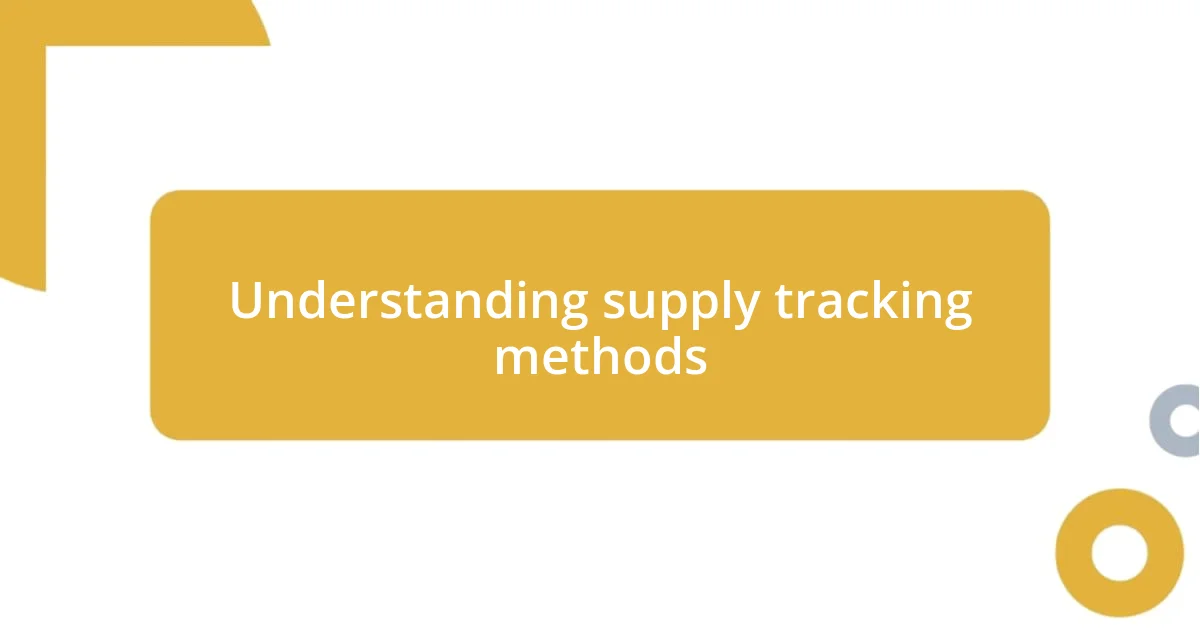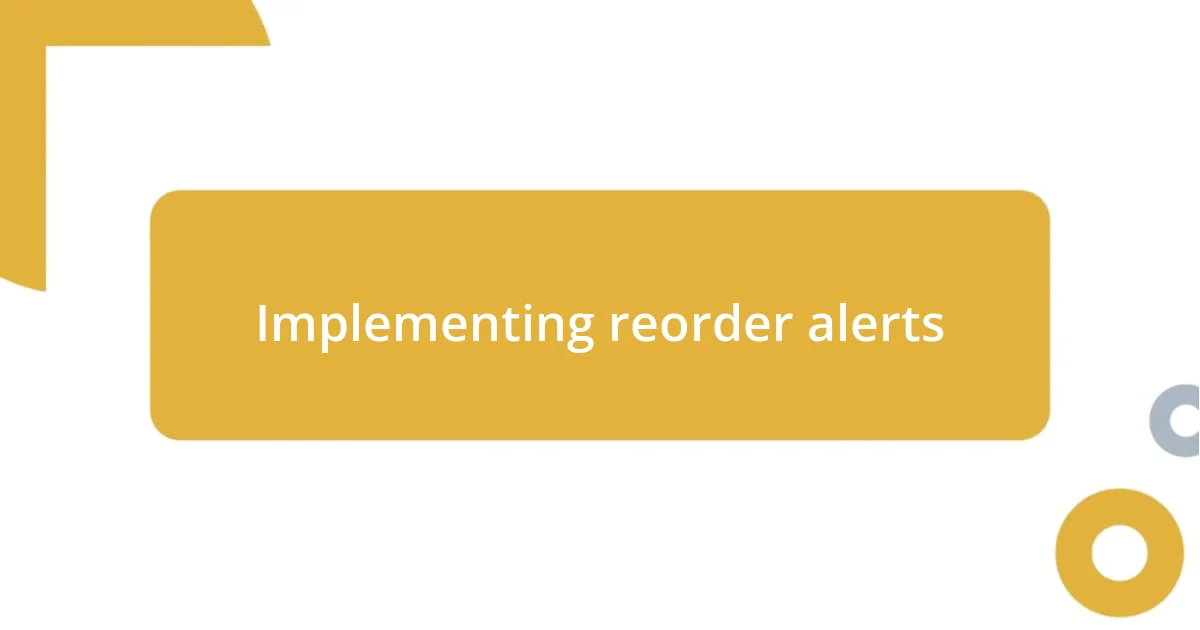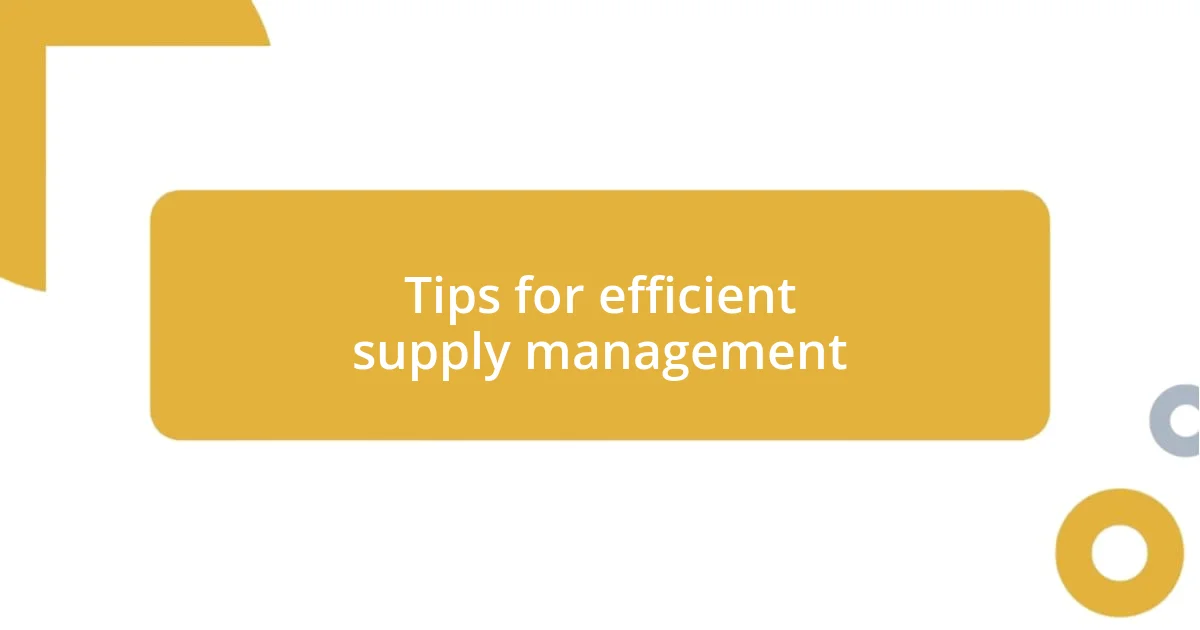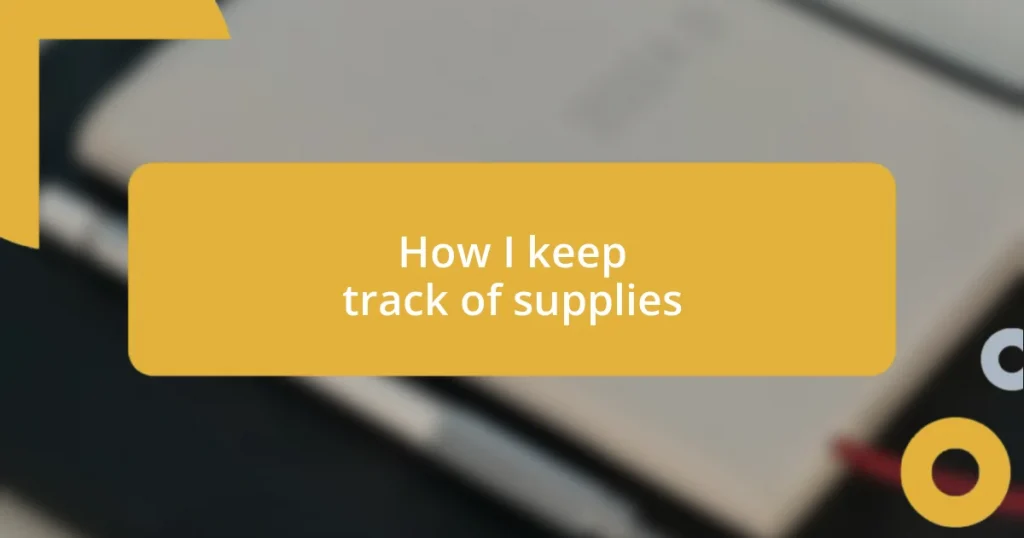Key takeaways:
- Effective supply tracking requires organization, including categorizing items and maintaining a dedicated inventory system.
- Utilizing digital tools like budgeting apps and inventory management software enhances efficiency and aids in identifying usage patterns.
- Regular updates, reminder alerts, and understanding usage trends significantly improve supply management and reduce last-minute scrambling for essentials.

Understanding supply tracking methods
When it comes to supply tracking methods, I often reflect on how essential organization is in my daily routine. I remember the early days when I would frantically search for items that were supposed to be restocked but weren’t. This chaotic experience taught me that using a dedicated inventory management system, whether digital or paper-based, can significantly ease the stress. Have you ever felt that panic when you realize you’re low on a crucial item just before an important project? It’s a feeling I’ve worked hard to avoid.
One method I’ve found incredibly effective is categorizing my supplies. For instance, I usually separate items by type—office supplies, cleaning materials, and kitchen essentials. This not only makes it easier to see what I have but also helps me understand what I frequently run out of. I used to underestimate the power of a simple spreadsheet until I saw how quickly I could spot trends, like when I often needed to restock certain items. Don’t you think it’s fascinating how a little organization can save you time and stress in the long run?
Another tracking approach that has been game-changing for me is setting up reminders. I usually schedule a monthly check-in to assess my supplies. This practice keeps me proactive instead of reactive. Imagine never having to scramble during a busy week again! By having that regular routine in place, I’ve noticed how much more in control I feel about my space and resources. Wouldn’t you agree that feeling organized can transform your productivity?

Choosing the right tracking tools
Choosing the right tracking tools can often feel overwhelming. I first started with basic lists and paper check-offs, but over time, I realized that a digital solution worked wonders for my efficiency. Using a user-friendly app not only streamlined my process, but it also saved me from the constant worry of misplacing my notes. Have you ever felt the frustration of losing a perfectly organized list right before a busy week? Trust me, switching to an app made all the difference for me.
As I explored various tools, I found something vital: the right tool should adapt to your personal needs. For example, I love using Budgeting apps for supply tracking because they offer visual insights into spending trends. This not only keeps my budget on track but also fosters an awareness of what I truly need over time. It’s fascinating how tailored tools can transform a mundane task into a more engaging experience, right? Just imagining my cleverly color-coded inventory gets me excited about restocking!
Then I encountered inventory management software, which might sound complex, but the user experience is surprisingly approachable. The stats and analytics they provide allow me to anticipate supply needs, which is especially useful during busy seasons. I remember when I was caught off guard during a holiday season, realizing I had little to no supplies on hand. That panic pushed me to adopt a more proactive approach. Now, I can glance at trends and avoid past mistakes, creating a sense of calm amidst the chaos of restocking.
| Tool Type | Benefits |
|---|---|
| Spreadsheets | Flexible, customizable, and easy to access. |
| Inventory Management Software | Advanced tracking features with analytical insights. |
| Budgeting Apps | Visual spending trends that enhance supply awareness. |

Regularly updating supply records
Updating my supply records regularly has become a routine that I genuinely cherish. Initially, I brushed off this task as a tedious chore, but I soon realized its importance in maintaining efficiency. I schedule a weekly review session that helps me stay connected to what I have on hand. There’s something satisfying about crossing items off my list, knowing I’ve kept everything in check. It reminds me of those times when I suddenly found myself short on materials just before deadlines, a panic I never want to feel again.
To make the process smoother, I follow these steps:
- Daily checks: I quickly glance at high-usage items to see if they’ve dipped low.
- Weekly updates: I dedicate a set time each week to update my master list and add any new supplies.
- Monthly assessments: I conduct a more comprehensive review to identify patterns in usage and anticipate restocking needs.
- Adjust as needed: If I notice recurring shortages, I adjust my purchasing habits—less guesswork means fewer surprises.
I remember the first time I skipped this update—it was chaos! I ended up scrambling to find basic supplies amidst the clutter, which led to unnecessary stress. Now, every tick in my log feels like a small victory, ensuring I always have what I need when I need it. How amazing is it to feel prepared and in control?

Implementing reorder alerts
Implementing reorder alerts is a game-changer for staying ahead of supply needs. I remember setting up my first alert—what a relief it was to know I wouldn’t run out of essentials. It’s like having a personal assistant who nudges me just when I need it. Do you ever wish you could automate the little details that seem to slip through the cracks? With reorder alerts, I don’t have to keep everything in my head—it’s all taken care of.
When I first implemented these alerts, I used a simple app feature that allowed me to set thresholds for specific items. For instance, when my paint supplies dipped below a certain level, I received a prompt. It’s incredible how this small tweak saved me from countless last-minute trips to the store. How often have you found yourself racing against time, desperately trying to find supplies at the eleventh hour? I’ve been there, and it’s not fun.
After a while, I realized I could tailor the alerts even further to fit busy periods. For example, during project launches, I increase the alert sensitivity, ensuring I’m never caught off guard. I still chuckle when I think of that one time I set my alerts too low and ended up with an embarrassing shortage right before my biggest client presentation! Now, I find comfort in knowing technology is there to support me, helping me stay organized and focused on what truly matters. What about you—how do you foresee using reorder alerts to improve your supply management?

Evaluating supply usage patterns
Understanding supply usage patterns has been a revelation for me. I’ve learned to observe how frequently I use certain items and at which times of the year they are particularly in demand. For example, I noticed that my stationery supplies take a hit at the beginning of each school year, prompting me to stock up in advance. Have you ever realized patterns in your own usage that made you change how you purchase?
I remember my first encounter with over-ordering. I bought a bulk supply of markers thinking it would save me money, only to find that most of them dried out before I ever got a chance to use them! Now, I keep track of not just what I use, but also how quickly I go through it. My strategy involves noting monthly consumption rates; it’s a simple practice that gives me clarity when making future orders. Do you keep a close eye on what you use, or do you just go with the flow?
Analyzing my supply usage has led me to reevaluate what I really need. For instance, instead of stocking up on items that hardly get used, I’ve learned to prioritize essentials that support my goals. The emotional relief that comes from having just what I need—without the clutter or waste—is something I cherish. It feels good to have confidence in my inventory management. What about you—how do you evaluate what supplies are essential for your work?

Tips for efficient supply management
One of the best strategies I’ve found for efficient supply management is categorizing my supplies. By organizing items into groups—like office supplies, tools, and art materials—I can easily see what I have on hand and what needs replenishing. Have you ever found treasure in your supply stash simply because you took a moment to organize? I still smile when recalling the time I discovered a forgotten box of highlighters, which completely changed how I tackled my next big project.
Another tip that has transformed my approach is maintaining a centralized inventory list. Using a simple spreadsheet, I list items, their quantities, and reordering thresholds. This practice has helped me stay accountable and aware of my supplies. I vividly remember the nerve-wracking moment when I went to start a project, only to find I had no glue left—a situation I’ve thankfully avoided ever since I got organized. How often do you find yourself in a panic over missing supplies?
Lastly, regular inventory check-ins have proven invaluable. I commit to a quick review every month, which not only keeps me ahead of my needs but also allows me to reflect on my consumption patterns. It’s almost meditative—taking the time to assess what works and what doesn’t. There’s something satisfying about knowing that I’ve reduced waste and optimized my supplies. Does your schedule allow for a moment of inventory peace, or are you racing against time to keep up?















